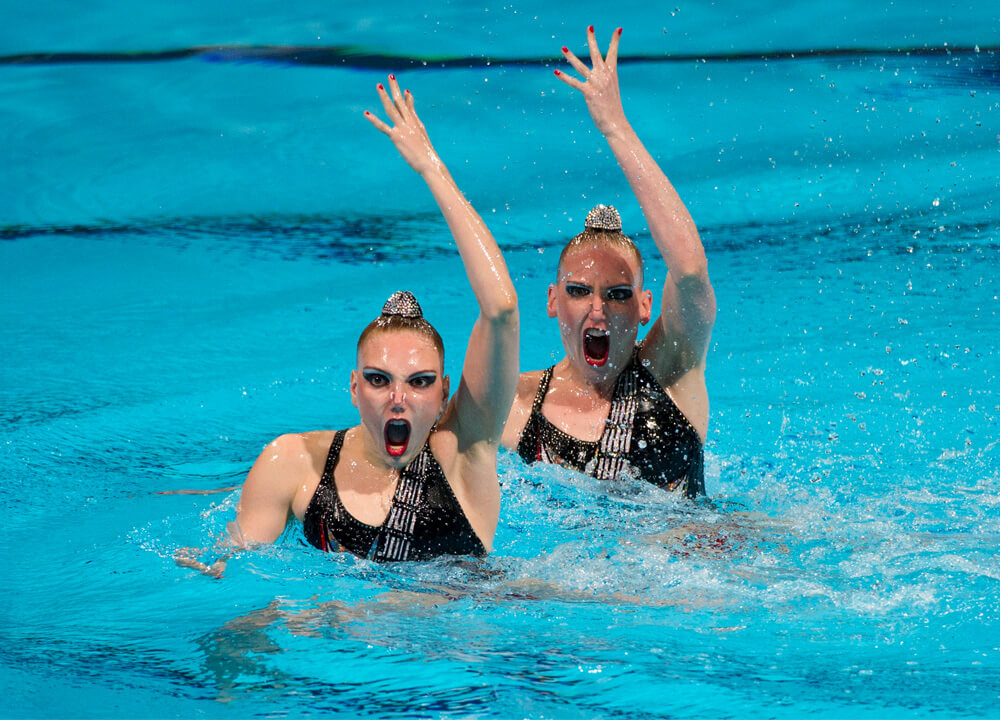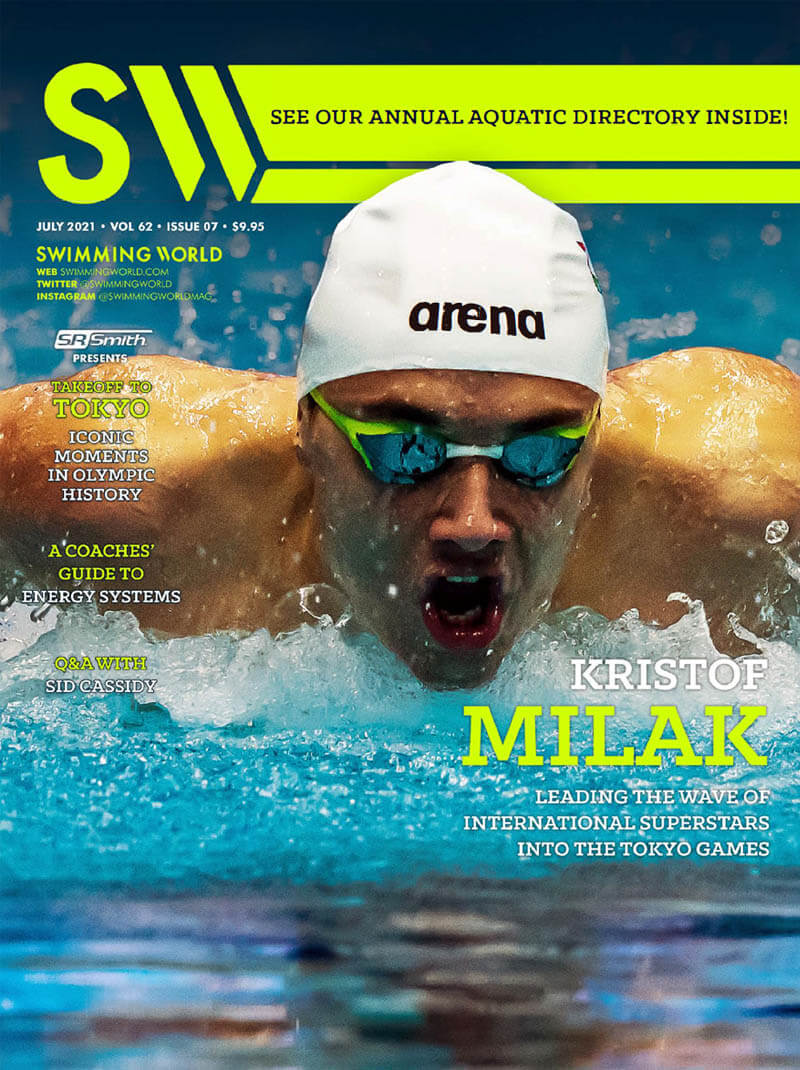Swimming World July 2021 Issue Presents – Artistic Swimming Olympic Preview: As Good As It Gets

The latest issue of Swimming World Magazine
is now available for download in the Swimming World Vault!
Non-Subscribers Can Download This Issue Here
Artistic Swimming Olympic Preview: As Good As It Gets
By Dan D’Addona
Russia is a perfect 10-for-10, winning every Olympic gold medal possible in artistic swimming—duet and team—since the turn of the century.
Synchronized swimming first became an Olympic sport in 1984.
In the early years, competition was held for solo, duet and team events, with the United States, Canada and Japan winning all the medals. In 1996, solo and duet were dropped from the program, with the USA winning the team gold.
By 2000, duet was reinstated and has remained with team as the current program. Then in 2017, synchronized swimming changed its name to artistic swimming.
One thing, though, that hasn’t changed since the turn of the century is the domination of Russia, which has won every gold medal possible. And Russia is poised to keep it that way in 2021.
Leading the way are Svetlana Romashina and Svetlana Kolesnichenko, who have never won a medal of any other color at the Olympics, World Championships or European Championships.
Most recently at the Europeans in May, the duo continued to dominate, earning one perfect mark in their duet free final, the only perfect score of the competition. The last time any judge handed out a perfect score came in 2010!
“It was such a happy moment when we saw the 10, because it is not so usual you can see that mark,” Kolesnischenko said. “It was so great. Seconds before Svetlana said to me, ‘Maybe 10’—and when I realized there was a 10 on the scoreboard—I said, ‘Look at this, Svetlana, there is a 10.’
“We hope to see more 10s in the future and, of course, we try to work harder, but now we are happy for the score, for our performance and our routine. And our coach, Tatiana Danchenko, told us the duet was good, so we are really satisfied.”
They also dominated the duet technical final and helped Russia win the team technical gold medal, beating Ukraine and Spain.
“It was good enough for this win, only,” Romashina said. “Our coach saw some mistakes that we need to correct if we want to win at the Olympics. This was a strong performance, but we need to improve. This gold medal is what we came here for, so we are happy with that.”
Get Swimming World Magazine and Swimming World Biweekly FREE When You
Become A Member of the International Swimming Hall of Fame
New! 30 Day Membership to ISHOF AND Digital Swimming World Subscription for just $10 a month!
Want more? Get a 1 Year ISHOF Family Membership With Swimming World Print AND Digital Subscription Order Now!
Non-Subscribers can click here to download this issue for only $5.94
FEATURES
010 | TOKYO OLYMPIC GAMES: READY FOR IMPACT
by Dan D’Addona, Matthew De George, John Lohn, David Rieder and Andy Ross
As the United States was still selecting its Olympic swimming team in mid-June, most countries had already decided who would be competing at the COVID-19 pandemic-delayed Olympic Games this summer. Here are profiles of 10 swimmers from around the world who have been preparing to make an impact in Tokyo.
022 | TAKEOFF TO TOKYO: ICONIC MOMENTS IN OLYMPIC HISTORY
by John Lohn
In October of 2019, nearly a year prior to the original date of the 2020 Olympic Games in Tokyo, Swimming World designed a series that would pay homage to the history of the sport on its biggest stage. For our final installment of “Takeoff to Tokyo,” we offer a look at some of the most prominent moments in Olympic lore.
026 | AS GOOD AS IT GETS
by Dan D’Addona
In our Olympic preview of artistic swimming, Swimming World notes that Russia is a perfect 10-for-10, winning every Olympic gold medal possible—duet and team—since the turn of the century. Led by Svetlana Romashina and Svetlana Kolesnichenko, Russia will be tough to beat next month, Aug. 2-7, in Tokyo.
COACHING
20 | SWIMMING TECHNIQUE CONCEPTS: MAXIMIZING SWIMMING VELOCITY (Part 3)—MINIMIZING THE ARM ENTRY PHASE TIME IN FREESTYLE AND BUTTERFLY
by Rod Havriluk
The non-propulsive time in a stroke cycle consists of the time for the entry phase and the recovery phase. This article presents strategies to minimize the entry phase time for freestyle and butterfly so that a swimmer can decrease stroke cycle time, increase stroke rate and increase swimming velocity.
040 | A COACHES’ GUIDE TO ENERGY SYSTEMS (Part 2)
by Michael J. Stott
Last month, Swimming World explored the concept of energy systems and how coaches can use them to maximize athlete development and performance. In Part 2, we examine how one incorporates his understanding of energy systems into a seasonal training plan.
042 | Q&A WITH COACH SID CASSIDY
by Michael J. Stott
043 | HOW THEY TRAIN MEGAN MORONEY AND ASPEN GERSPER
by Michael J. Stott
TRAINING
019 | DRYSIDE TRAINING: SUMMER SPEED
by J.R. Rosania
JUNIOR SWIMMER
45 | UP & COMERS: KAYLA HAN
by Shoshanna Rutemiller
COLUMNS & SPECIAL SECTIONS
008 | A VOICE FOR THE SPORT
018 | THE OFFICIAL WORD
027 | 2021 AQUATIC DIRECTORY
046 | GUTTERTALK
047 | PARTING SHOT
Swimming World is now partnered with the International Swimming Hall of Fame. To find out more, visit us at ishof.org




